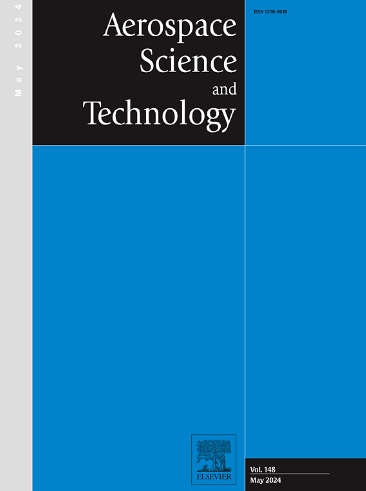烧蚀条件下高超声速非平衡流动与炭化材料热响应的隐式耦合框架
IF 5
1区 工程技术
Q1 ENGINEERING, AEROSPACE
引用次数: 0
摘要
提出了高超声速非平衡流动与材料热响应的隐式耦合框架,用于烧蚀热防护材料在飞行过程中的数值模拟。当受到高超声速气流的气动加热时,烧蚀材料会经历烧蚀和热解等复杂的过程,其中涉及非均相和均相化学反应。使用多组分材料热响应(MTR)求解器模拟这些多物理现象,该求解器考虑了热解气体组分的复杂性。为了提高热解气体输运和热物性参数的准确性,计算了各组分的浓度。通过对测试用例进行隐式时间积分,MTR求解器的效率提高了92%。高超声速流动和材料热响应的数值解通过气-面相互作用(GSI)界面耦合,该界面基于烧蚀表面的表面质量和能量平衡。根据GSI接口的更新时间,提出了显式耦合方法和隐式耦合机制。显式耦合方法在物理时间步长更新界面量,使计算效率提高了40%,但引入了时间离散误差和壁面性质的数值振荡。相比之下,隐式耦合机制以伪时间步长更新界面量,将时间离散化误差降低了5.8%,并抑制了数值振荡。此外,提出了基于稳态烧蚀假设的简化烧蚀边界来近似MTR解,给出了烧蚀存在时的准定常流动解。本文章由计算机程序翻译,如有差异,请以英文原文为准。
An implicit coupling framework for numerical simulations between hypersonic nonequilibrium flows and thermal responses of charring materials in the presence of ablation
An implicit coupling framework for hypersonic nonequilibrium flows and material thermal responses is proposed for numerical simulations of ablative thermal protection materials during flight trajectories. When subjected to aerodynamic heating from hypersonic flows, charring ablative materials undergo complex processes such as ablation and pyrolysis, which involve heterogeneous and homogeneous chemical reactions. These multiphysical phenomena are simulated using a multicomponent material thermal response (MTR) solver that accounts for the complexity of the components of pyrolysis gases. The species concentrations are calculated to enhance the accuracy of the transport and thermophysical parameters of pyrolysis gases. The efficiency of the MTR solver is improved by 92% through implicit time integration in the test cases. The numerical solutions of hypersonic flows and material thermal response are coupled through a gas-surface interaction (GSI) interface, which is based on the surface mass and energy balance on the ablating surface. An explicit coupling method and an implicit coupling mechanism are developed depending on when the GSI interface is updated. The explicit coupling method updates the interfacial quantities at physical time steps, which improves computational efficiency by 40%, but introduces time discretization errors and numerical oscillations in wall properties. In contrast, the implicit coupling mechanism updates the interfacial quantities at pseudo time steps, reducing temporal discretization errors by up to 5.8% and suppressing numerical oscillations. Additionally, a simplified ablation boundary based on a steady-state ablation assumption is proposed to approximate the MTR solution, providing quasi-steady flow solutions in the presence of ablation.
求助全文
通过发布文献求助,成功后即可免费获取论文全文。
去求助
来源期刊

Aerospace Science and Technology
工程技术-工程:宇航
CiteScore
10.30
自引率
28.60%
发文量
654
审稿时长
54 days
期刊介绍:
Aerospace Science and Technology publishes articles of outstanding scientific quality. Each article is reviewed by two referees. The journal welcomes papers from a wide range of countries. This journal publishes original papers, review articles and short communications related to all fields of aerospace research, fundamental and applied, potential applications of which are clearly related to:
• The design and the manufacture of aircraft, helicopters, missiles, launchers and satellites
• The control of their environment
• The study of various systems they are involved in, as supports or as targets.
Authors are invited to submit papers on new advances in the following topics to aerospace applications:
• Fluid dynamics
• Energetics and propulsion
• Materials and structures
• Flight mechanics
• Navigation, guidance and control
• Acoustics
• Optics
• Electromagnetism and radar
• Signal and image processing
• Information processing
• Data fusion
• Decision aid
• Human behaviour
• Robotics and intelligent systems
• Complex system engineering.
Etc.
 求助内容:
求助内容: 应助结果提醒方式:
应助结果提醒方式:


